Experimental Investigation on the Characteristic Mobilization and Remaining Oil Distribution under CO2 Huff-n-Puff of Chang 7 Continental Shale Oil
Abstract
:1. Introduction
2. Fundamental Theory
2.1. Pore Radius Conversion Theory Based on NMR
2.2. Relationship between T2 Spectrum and the Remaining Oil Content
3. Experiments
3.1. Materials
3.2. Experimental Apparatus
3.3. Experimental Procedures
- (1)
- Core preparation: we prepared the shale cores by a linear cutting machine with a diameter of 25 mm, and we cleaned the samples for 28 days. Afterwards, they with dried at 120 °C for about 3 days, and the permeability and porosity were tested by helium.
- (2)
- SEM tests: we took the core slice from the standard sample and polished the surface. Then, the polished sample was photographed by FESEM.
- (3)
- Rock sample saturation: we vacuumed the core samples for 72 h. Next, the specimens were saturated with n-dodecane for 48 h at 30 MPa and 45 °C, and then we put them into the container with n-dodecane for one week to completely saturate at 45 °C. Additionally, the samples were weighed before and after the processes.
- (4)
- Initial T2 spectrum: after saturation, we measured the samples with an NMR apparatus to obtain the initial T2 spectrum curves of the saturated oil.
- (5)
- CO2 huff: first, we put the core into the huff-n-puff vessel, and then, as shown in Figure 4, the experimental process was connected. After we filled the huff-n-puff vessel with CO2 from the cylinder, CO2 in the plug-type container was injected into the huff-n-puff vessel by the ISCO pump at 15 MPa.
- (6)
- CO2 puff: all valves were closed during the soaking period for 12 h. We opened valve #3 and controlled the back pressure to gradually drop to 0 MPa.
- (7)
- CO2 huff-n-puff T2 spectrum: we took out the core from the huff-n-puff vessel, and then we weighed the sample by the analytical electronic balance and measured the T2 spectrum using the NMR apparatus.
- (8)
- We repeated steps (5)–(7) at the same injection pressure of 4 rounds for the CO2 huff-n-puff experiments and NMR tests.
4. Results and Discussions
4.1. Pore Characteristics and Radius Distribution
4.2. Recovery Factor of CO2 Huff-n-Puff Process
4.2.1. Effect of Cycle Number
4.2.2. Effect of Permeability
4.3. Microscopic Process with NMR Tests
4.3.1. Characteristics of Shale Oil Mobilization
4.3.2. Characteristics of Remaining Oil Distribution
5. Process and Mechanism Analysis of CO2 Huff-n-Puff
- (1)
- In the first huff-n-puff cycle, CO2 was preferentially injected into the macropores with smaller capillary resistance under the pressure differential effect. Additionally, CO2 was dissolved in the crude oil to generate oil swelling, pressurization, and viscosity reduction. Then, the oil was rapidly produced. Secondly, a small amount of CO2 entered the mesopores and smallpores to produce a little oil. Finally, a tiny amount of oil was obtained by CO2 with diffusion in micropores.
- (2)
- With the cycle numbers increased, most of the crude oil in the macropores drained, and then the flow resistance and CO2 consumption in the macropores reduced. Therefore, the concentration of the CO2 that contacted and reacted with the remaining oil in the mesopores and smallpores was relatively higher, and the crude oil could be further extracted. However, as shown in Figure 14 and Table 4, the ORF and the percentage of oil production in meso and smallpores both sharply reduced after three injection cycles in this experiment. Analyses have shown that the proportion of adsorbed oil in such pores is higher than that in macropores [36,37], and after several cycles of CO2 huff-n-puff, the free oil basically discharged but the adsorbed oil was hard to extract.
- (3)
- For the micropores that accounted for more than half of the total pore volume, the shale oil recovery factor was generally at a low level. As shown in Figure 14, though the ORF was found to be the highest in the second cycle, it was also only 3.27% and 4.14% in the first and second cycles, respectively. An analysis showed that the capillary resistance was very large due to the tiny pore size of the micropores. Then, the CO2 mainly entered into the micropores through diffusion to interact with shale oil. Thus, the total amount and rate of CO2 entering the micropores were both lower. Meanwhile, with the production of shale oil in other pores, more CO2 flowed towards the micropores, and the amount of CO2 diffused into the micropores increased, leading to the free oil with a low proportion to quickly discharge. However, the adsorption effect of micropores was stronger, and the remaining adsorbed oil was more difficult to extract. This resulted in the shale oil recovery factor significantly reducing after two cycles of CO2 huff-n-puff.
6. Conclusions
- (1)
- In order to study the pore structure of Chang 7 continental shale, a series of SEM and NMR tests were conducted. The SEM images showed that there were massive micro-smallpores and fractures, as well as a few large-scale pores. These results qualitatively characterized the complexity of the pore structure. Furthermore, the T2 spectrum curves of saturated oil and remaining oil had two and three wave crests, respectively. We could quantitatively classify the pores into four types, namely micropore, smallpore, mesopore, and macropore. The proportions of the different pore volumes were 56.38% and 60.26%, 13.57% and 11.93%, 19.19% and 18.29%, 10.85%, and 9.53%, respectively, in the two samples. The above results indicated a strong heterogeneity of the Chang 7 continental shale.
- (2)
- With the huff-n-puff cycle number, the cumulative ORF gradually increased in the natural logarithmic form, and the single-cycle ORF rapidly decreased in the exponential form. Additionally, the fifth cycle was only 1.37% and 1.29%, respectively, for the aforementioned forms. This shows that an economic production comprises about three-to-five cycles for the shale oil reservoir. Additionally, the higher the permeability was, the higher the ORF was found to be. However, each pore was mainly composed of micropores, and the total capillary force and oil flow resistance were higher, resulting in a difference of ORF that was far less than that of permeability between the two experimental samples.
- (3)
- A battery of NMR T2 spectrum curves of the CO2 huff-n-puff reflected the recovery factors and remaining oil content of different pores. After five cycles, for the experimental samples, the average cumulative ORF of macropores was greater than 97%, and the mesopores, smallpores, and micropores had average cumulative ORFs of 70.94%, 64.71%, and 13.89%, respectively. Meanwhile, the final remaining oil of micropores accounted for 82.29% of the total amount, and the smallpores, mesopores, and large pores accounted for 8.35%, 8.90%, and less than 0.5%, respectively. These results suggest that the remaining oil was mainly in micropores and rarely in macropores. This reflects that there were great differences in the characteristics of mobilization and the remaining oil micro-distribution among different sizes of pores.
- (4)
- The shale oil was usually stored freely and adsorbed in the pores. However, the proportion of adsorbed oil in the micropores was higher than that in macropores, and the adsorbed oil was hard to extract. Additionally, the CO2 could more easily flow into macropores, mesopores, and smallpores under the pressure differential effect. However, only small amount of CO2 could slowly diffuse into the micropores, resulting the differences of oil production and remaining oil micro-distribution.
- (5)
- For the Chang 7 continental shale, large-scale fracturing and acidizing may comprise foundation to promote a better contact and reaction between CO2 and shale oil in micropores. Then, one could effectively develop shale oil, reduce remaining oil, and enhance shale oil recovery.
Author Contributions
Funding
Acknowledgments
Conflicts of Interest
References
- Solarin, S.A.; Gil Alana Luis, A.; Lafuente, C. An investigation of long range reliance on shale oil and shale gas production in the U.S. market. Energy 2019, 195, 116933. [Google Scholar] [CrossRef]
- Energy Information Administration. U.S. Energy Facts—Energy Explained. 2019. Available online: https://www.eia.gov/energyexplained/?page=us_energy_home (accessed on 17 May 2019).
- Zhao, W.Z.; Hu, S.Y.; Hou, L.H. Connotation and strategic role of in-situ conversion processing of shale oil underground in the onshore China. Pet. Explor. Dev. 2018, 45, 537–545. [Google Scholar] [CrossRef]
- Hu, S.; Zhao, W.; Hou, L.; Yang, Z.; Zhu, R.; Wu, S.; Bai, B.; Jin, X. Development potential and technical strategy of continental shale oil in China. Pet. Explor. Dev. 2020, 47, 819–828. [Google Scholar] [CrossRef]
- Zhao, W.; Hu, S.; Hou, L.; Yang, T.; Li, X.; Guo, B.; Yang, Z. Types and resource potential of continental shale oil in China and its boundary with tight oil. Pet. Explor. Dev. 2020, 47, 1–11. [Google Scholar] [CrossRef]
- Gamadi, T.D.; Sheng, J.J.; Soliman, M.Y. An experimental study of cyclic gas Injection to Improve shale oil recovery. In Proceedings of the SPE Annual Technical Conference and Exhibition, New Orleans, LA, USA, 30 September–2 October 2013. [Google Scholar] [CrossRef]
- Sun, R.; Yu, W.; Xu, F.; Pu, H.; Miao, J. Compositional simulation of CO2 Huff-n-Puff process in Middle Bakken tight oil reservoirs with hydraulic fractures. Fuel 2019, 236, 1446–1457. [Google Scholar] [CrossRef]
- Sheng, J.J. Enhanced oil recovery in shale reservoirs by gas injection. J. Nat. Gas Sci. Eng. 2015, 22, 252–259. [Google Scholar] [CrossRef] [Green Version]
- Sheng, J.J.; Chen, K. Evaluation of the EOR potential of gas and water injection in shale oil reservoirs. J. Unconv. Oil Gas Resour. 2014, 5, 1–9. [Google Scholar] [CrossRef]
- Elwegaa, K.; Emadi, H.; Soliman, M.; Gamadi, T.; Elsharafi, M. Improving oil recovery from shale oil reservoirs using cyclic cold carbon dioxide injection-An experimental study. Fuel 2019, 254, 115586. [Google Scholar] [CrossRef]
- Sheng, J.J.; Mody, F.; Griffith, P.J.; Barnes, W.N. Potential to increase condensate oil production by huff-n-puff gas injection in a shale condensate reservoir. Nat. Gas Sci. Eng. 2013, 28, 46–51. [Google Scholar] [CrossRef] [Green Version]
- Jia, B.; Tsau, J.; Barati, R. A review of the current progress of CO2 injection EOR and carbon storage in shale oil reservoirs. Fuel 2019, 236, 404–427. [Google Scholar] [CrossRef]
- Li, L.; Su, Y.; Hao, Y.; Zhan, S.; Lv, Y.; Zhao, Q.; Wang, H. A comparative study of CO2 and N2 huff-n-puff EOR performance in shale oil production. J. Pet. Sci. Eng. 2019, 181, 106174. [Google Scholar] [CrossRef]
- Li, L.; Sheng, J.J.; Watson, M.; Mody, F. Experimental and Numerical Upscale Study of Cyclic Methane Injection to Enhance Shale Oil Recovery. In Proceedings of the AIChE Annual Conference, Salt Lake City, UT, USA, 8–13 November 2015. [Google Scholar]
- Weijermars, R.; Nandlal, K.; Khanal, A.; Tugan, M.F. Comparison of pressure front with tracer front advance and principal flow regimes in hydraulically fractured wells in unconventional reservoirs. J. Pet. Sci. Eng. 2019. [Google Scholar] [CrossRef]
- Ho Tuan, A.; Wang, Y. Enhancement of oil flow in shale nanopores by manipulating friction and viscosity. Phys. Chem. Chem. Phys. PCCP 2019, 21, 1–10. [Google Scholar]
- Yu, H.; Qi, S.; Chen, Z.; Cheng, S.; Xie, Q.; Qu, X. Simulation Study of Allied In-Situ Injection and Production for Enhancing Shale Oil Recovery and CO2 Emission Control. Energies 2019, 12, 3961. [Google Scholar] [CrossRef] [Green Version]
- Gamadi Talal, D.; Elldakli, F. Compositional Simulation Evaluation of EOR Potential in Shale Oil Reservoirs by Cyclic Natural Gas Injection. In Proceedings of the SPE/AAPG/SEG Unconventional Resources Technology Conference, Denver, CO, USA, 25–27 August 2014. [Google Scholar]
- Li, L.; Sheng James, J. Gas Selection for Huff-n-Puff FOR in Shale Oil Reservoirs Based upon Experimental and Numerical Study. In Proceedings of the SPE Unconventional Resources Conference, Society of Petroleum Engineers, Calgary, AB, Canada, 15–16 February 2017. [Google Scholar]
- Tao, W. Evaluate EOR Potential in Fractured Shale Oil Reservoirs by Cyclic Gas Injection. In Proceedings of the Unconventional Resources Technology Conference, Denver, CO, USA, 12–14 August 2013. [Google Scholar]
- Wan, T.; Sheng, J. Compositional Modelling of the Diffusion Effect on EOR Process in Fractured Shale-Oil Reservoirs by Gas flooding. J. Can. Pet. Technol. 2015, 54, 2248–2264. [Google Scholar] [CrossRef]
- Gamadi, T.D.; Sheng, J.J.; Soliman, M.Y.; Menouar, H.; Watson, M.C.; Emadibaladehi, H. An experimental study of cyclic CO2 Injection to Improve shale oil recovery. In Proceedings of the SPE Improved Oil Recovery Symposium, Tulsa, OK, USA, 12–16 April 2014. [Google Scholar] [CrossRef]
- Zhang, Y.; Yu, W.; Li, Z.; Sepehrnoori, K. Simulation study of factors affecting CO2 huff-n-puff process in tight oil reservoirs. J. Pet. Sci. Eng. 2018, 163, 264–269. [Google Scholar] [CrossRef]
- Wei, B.; Zhong, M.; Gao, K.; Li, X.; Zhang, X.; Cao, J.; Lu, J. Oil recovery and compositional change of CO2 huff-n-puff and continuous injection modes in a variety of dual-permeability tight matrix-fracture model. Fuel 2020, 276, 117939. [Google Scholar] [CrossRef]
- Wang, X.; Xiao, P.; Yang, Z.; Liu, X.-W.; Xia, Z.-Z.; Wang, L.-Q. Laboratory and field-scale parameter optimization of CO2 huff-n-puff with the staged-fracturing horizontal well in tight oil reservoir. J. Pet. Sci. Eng. 2019, 186, 106703. [Google Scholar] [CrossRef]
- Li, J.; Jin, W.; Wang, L.; Wu, Q.; Lu, J.; Hao, S. Quantitative evaluation of organic and inorganic pore size distribution by NMR: A case from the Silurian Longmaxi Formation gas shale in Fuling area, Sichuan Basin. Oil Gas Geol. 2016, 37, 129–134. [Google Scholar] [CrossRef]
- Liu, J.; Sheng, J.J. Experimental investigation of surfactant enhanced spontaneous imbibition in Chinese shale oil reservoirs using NMR tests. J. Ind. Eng. Chem. 2018, 72, 414–422. [Google Scholar] [CrossRef]
- Gu, X.; Pu, C.; Huang, H.; Huang, F.; Li, Y.; Liu, Y.; Liu, H. Micro-influencing mechanism of permeability on spontaneous imbibition recovery for tight sandstone reservoirs. Pet. Explor. Dev. 2017, 44, 948–954. [Google Scholar] [CrossRef]
- Lai, F.; Li, Z.; Wei, Q.; Zhang, T.; Zhao, Q. Experimental investigation of spontaneous imbibition in tight reservoir with nuclear magnetic resonance testing. Energy Fuels 2016, 30, 8932–8940. [Google Scholar] [CrossRef]
- Nie, X.; Chen, J. Nuclear Magnetic Resonance Measurement of Oil and Water Distributions in Spontaneous Imbibition Process in Tight Oil Reservoirs. Energies 2018, 11, 3114. [Google Scholar] [CrossRef] [Green Version]
- Pu, W.; Wei, B.; Jin, F.; Li, Y.; Jia, H.; Liu, P.; Tang, Z. Experimental investigation of CO2 huff-n-puff process for enhancing oil recovery in tight reservoirs. Chem. Eng. Res. Des. 2016, 111, 13256–13271. [Google Scholar] [CrossRef]
- Ma, Q.; Yang, S.; Lv, D.; Wang, M.; Chen, J.; Kou, G.; Yang, L. Experimental investigation on the influence factors and oil production distribution in different pore sizes during CO2 huff-n-puff in an ultra-high-pressure tight oil reservoir. J. Pet. Sci. Eng. 2019, 178, 1155–1163. [Google Scholar] [CrossRef]
- Alfarge, D.; Wei, M.; Bai, B. CO2-EOR mechanisms in huff-n-puff operations in shale oil reservoirs based on history matching results. Fuel 2018, 226, 112–120. [Google Scholar] [CrossRef]
- Alfarge, D.; Wei, M.; Bai, B. Factors affecting CO2-EOR in shale-oil reservoirs: Numerical simulation study and pilot tests. Energy Fuel 2017. [Google Scholar] [CrossRef]
- Lang, D.; Lun, Z.; Lyu, C.; Wang, H.; Zhao, Q.; Sheng, H. Nuclear magnetic resonance experimental study of CO2 injection to enhance shale oil recovery. Pet. Explor. Dev. 2021, 48, 1–10. [Google Scholar]
- Zhang, S.; Li, , Y.; Pu, H. Studies of the storage and transport of water and oil in organic-rich shale using vacuum imbibition method. Fuel 2020, 266, 117096. [Google Scholar] [CrossRef]
- Cui, J.; Cheng, L. A theoretical study of the occurrence state of shale oil based on the pore sizes of mixed Gaussian distribution. Fuel 2017, 206, 564–571. [Google Scholar] [CrossRef]

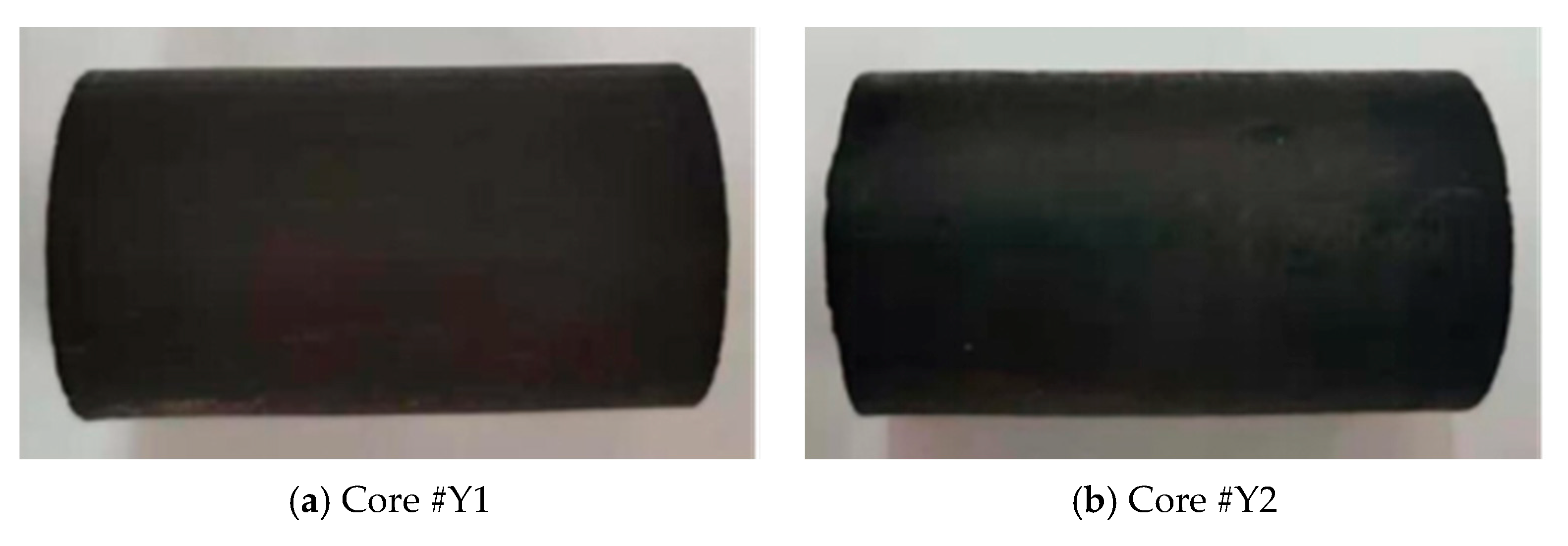
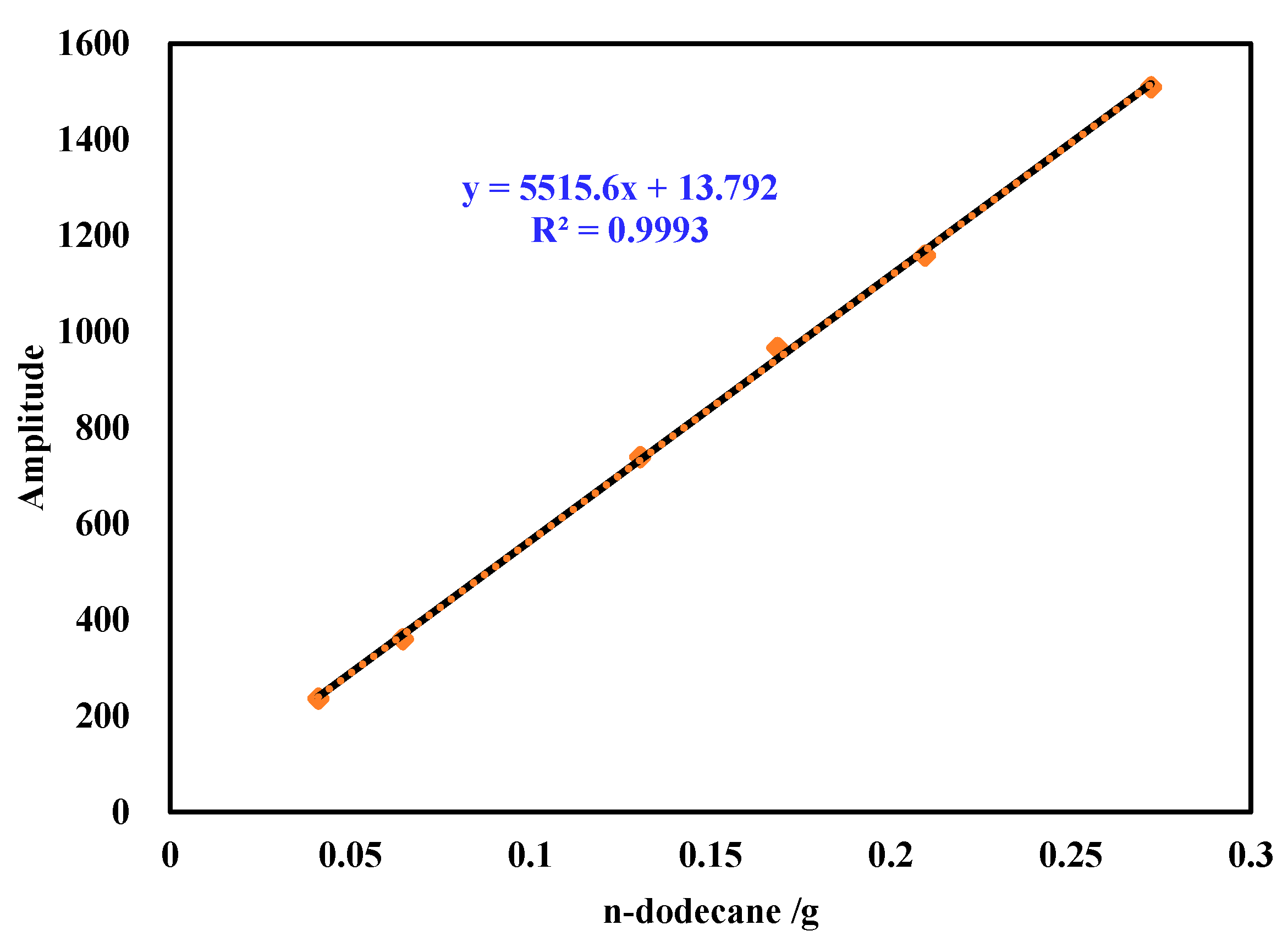
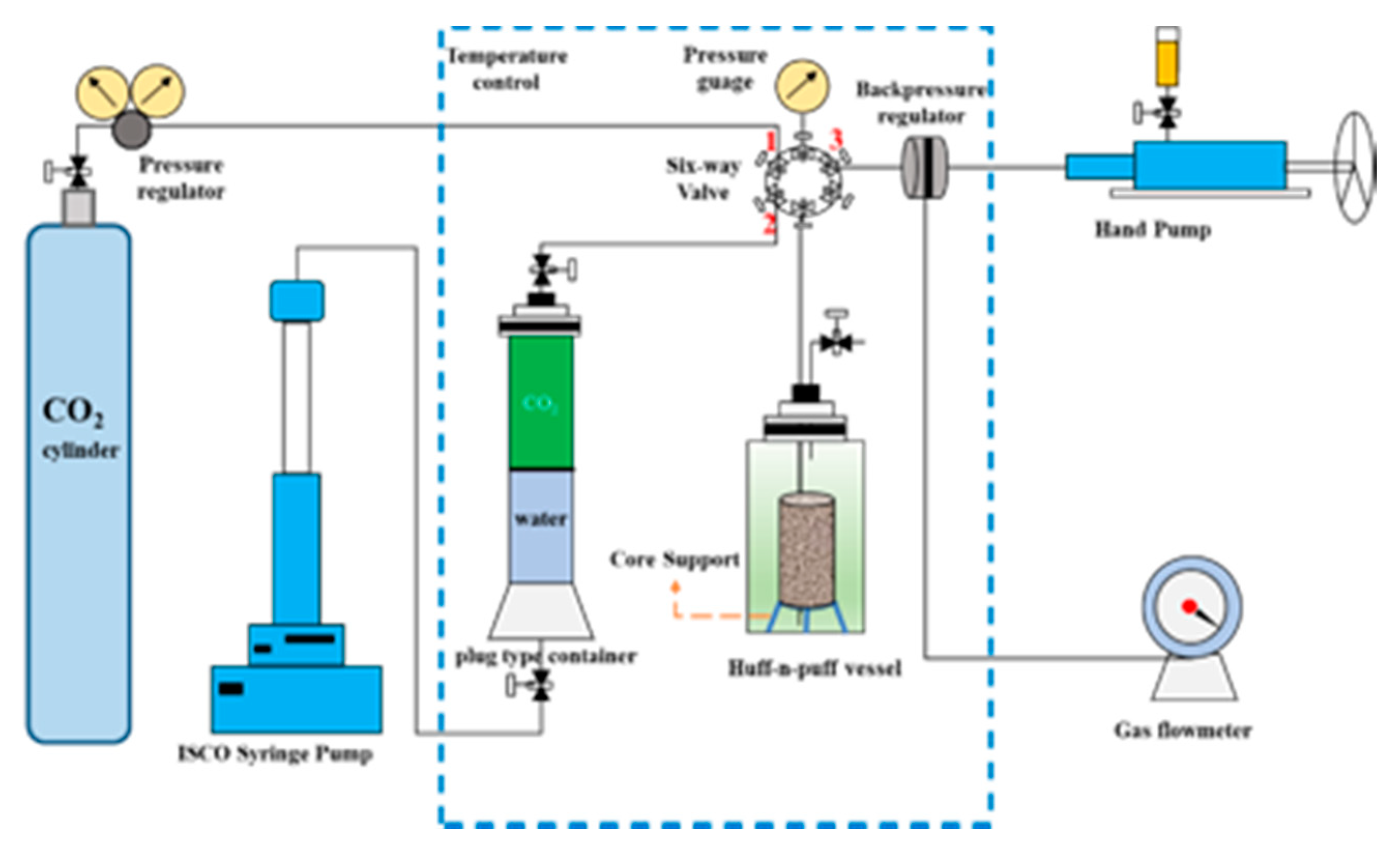
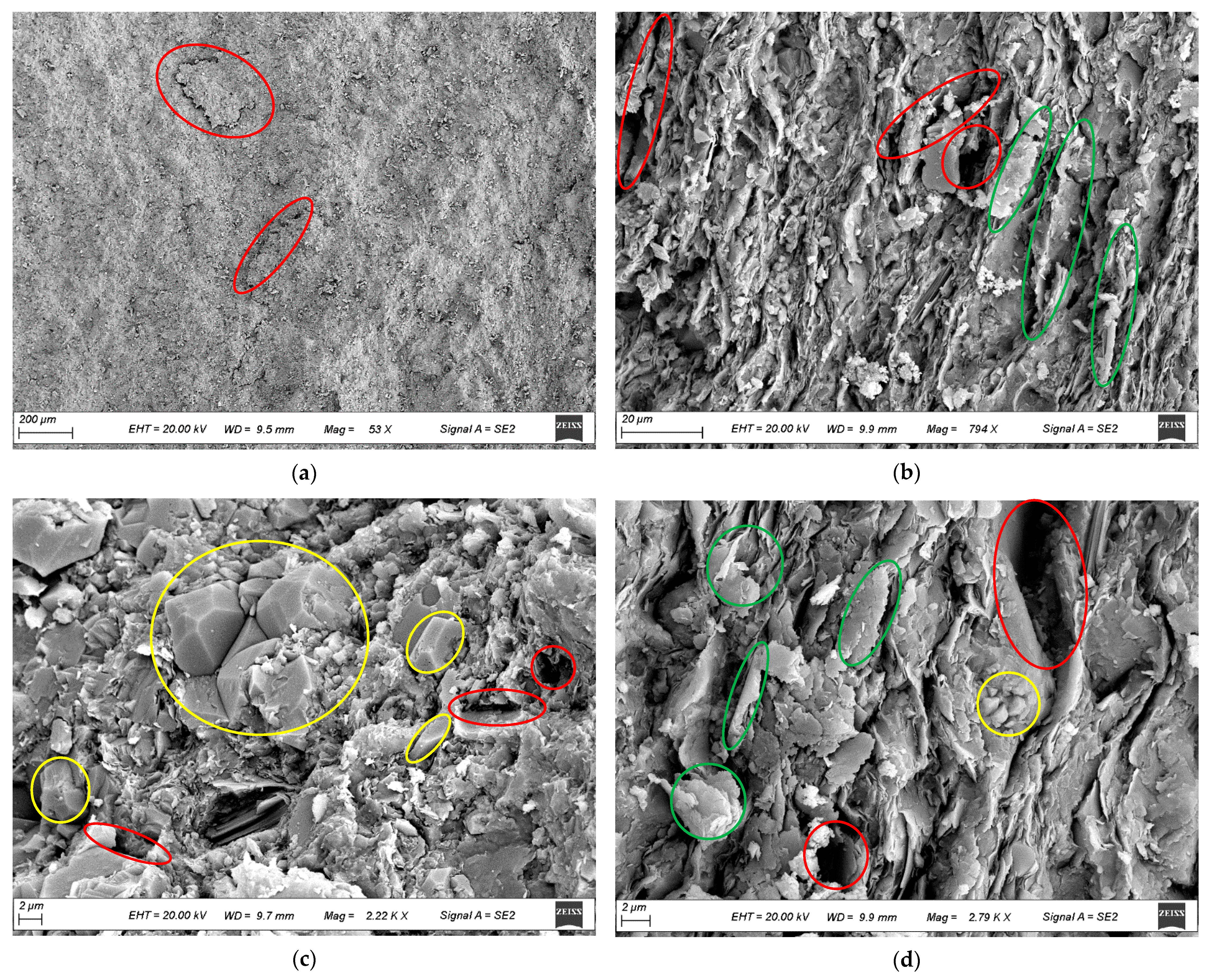
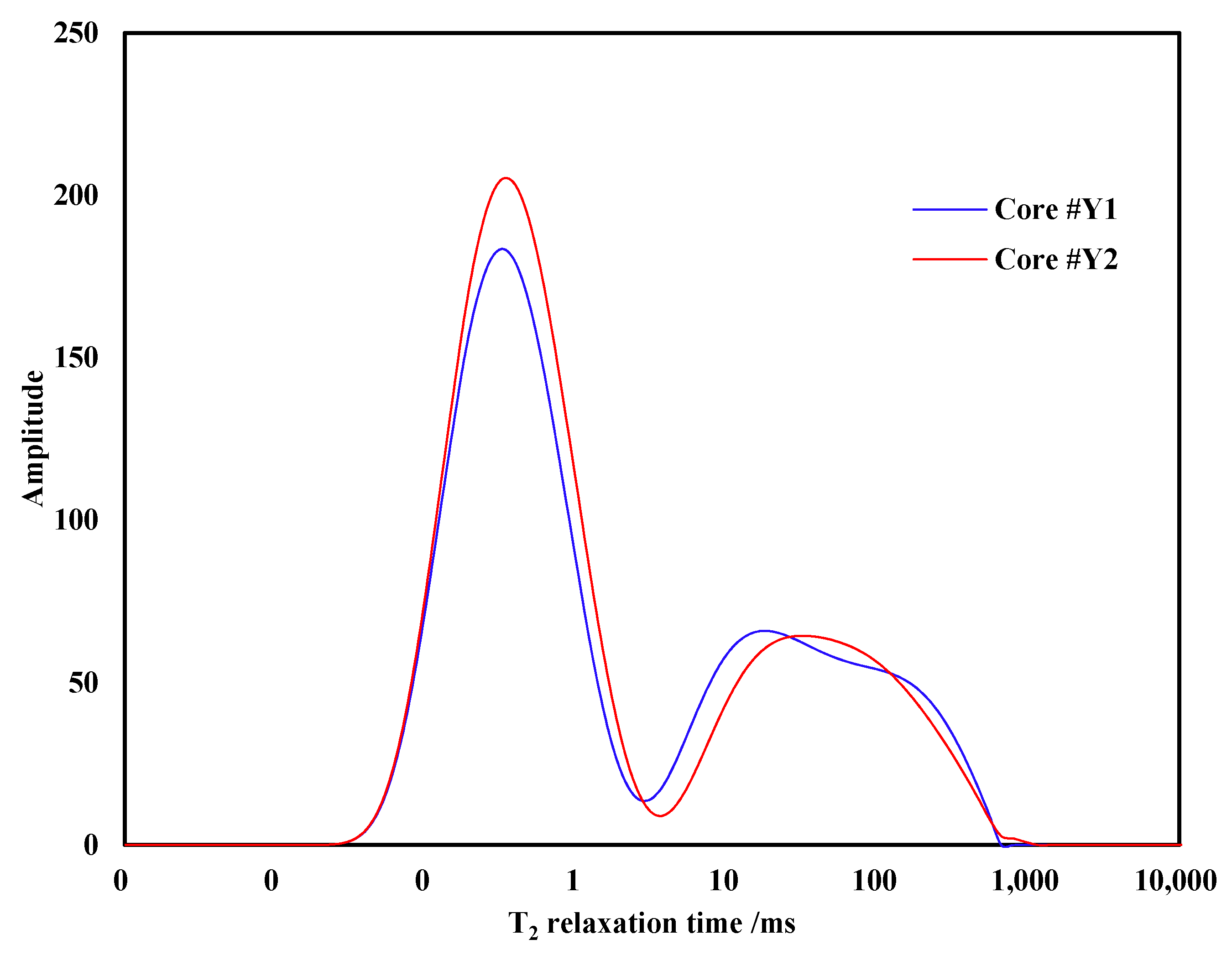
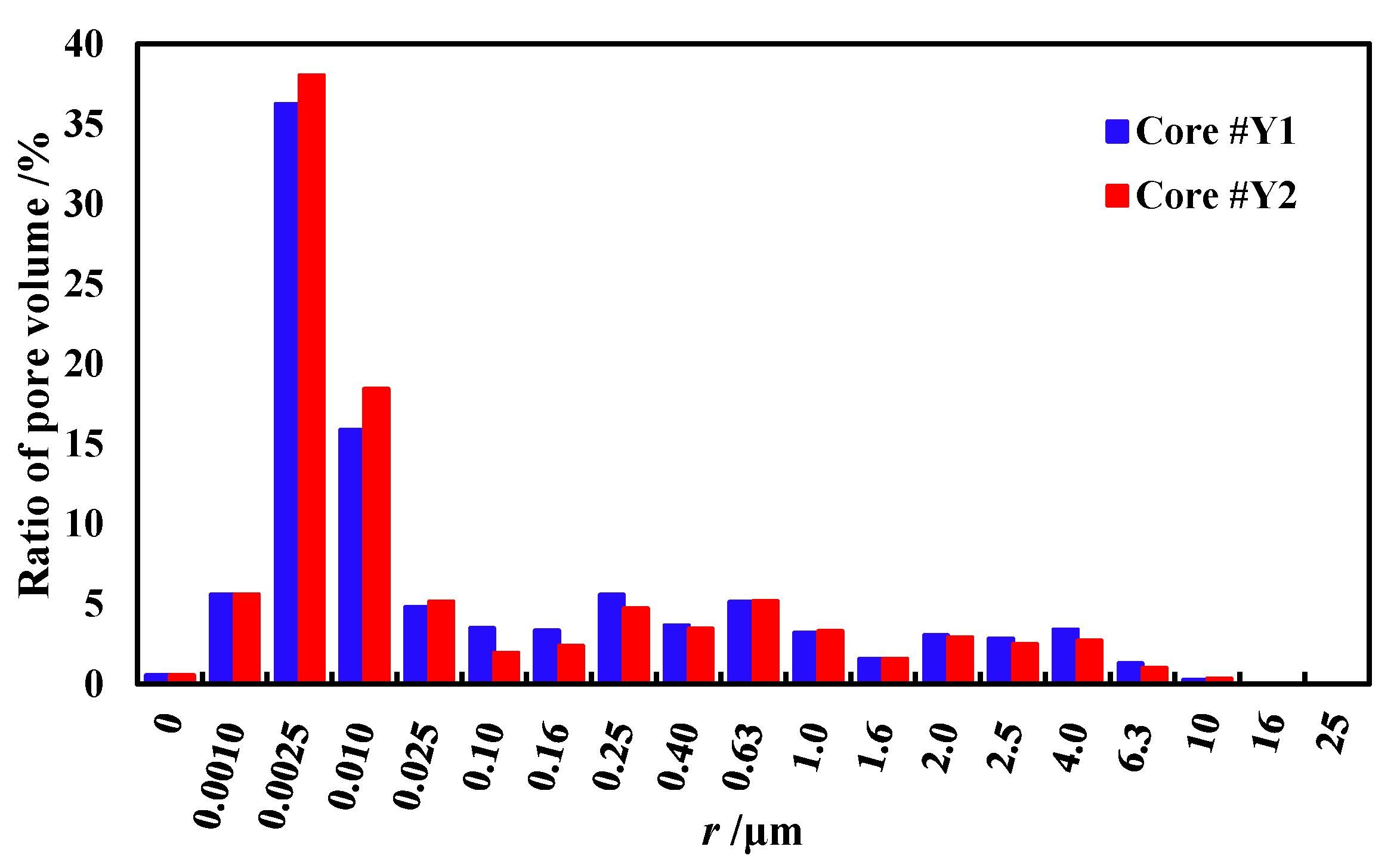
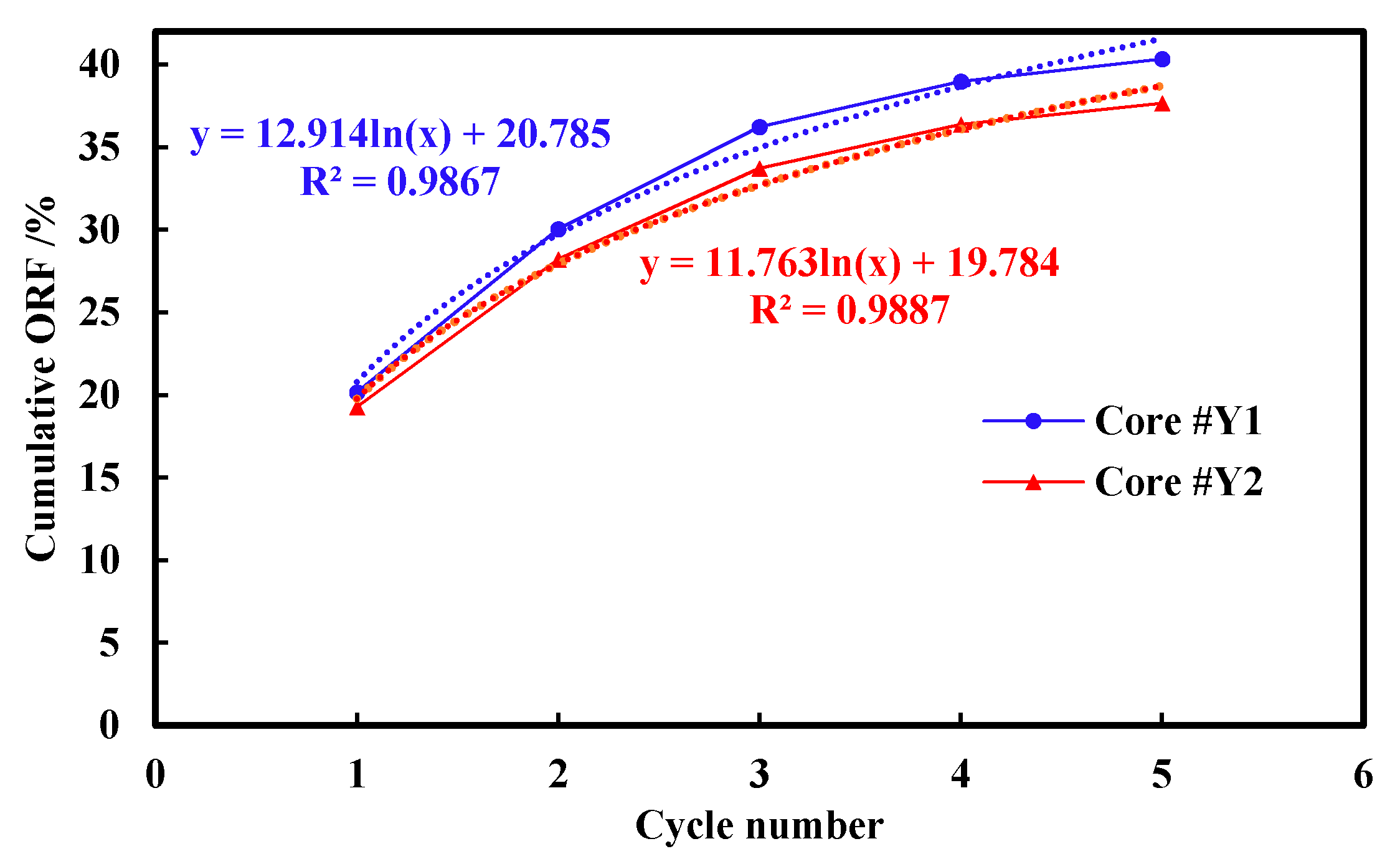
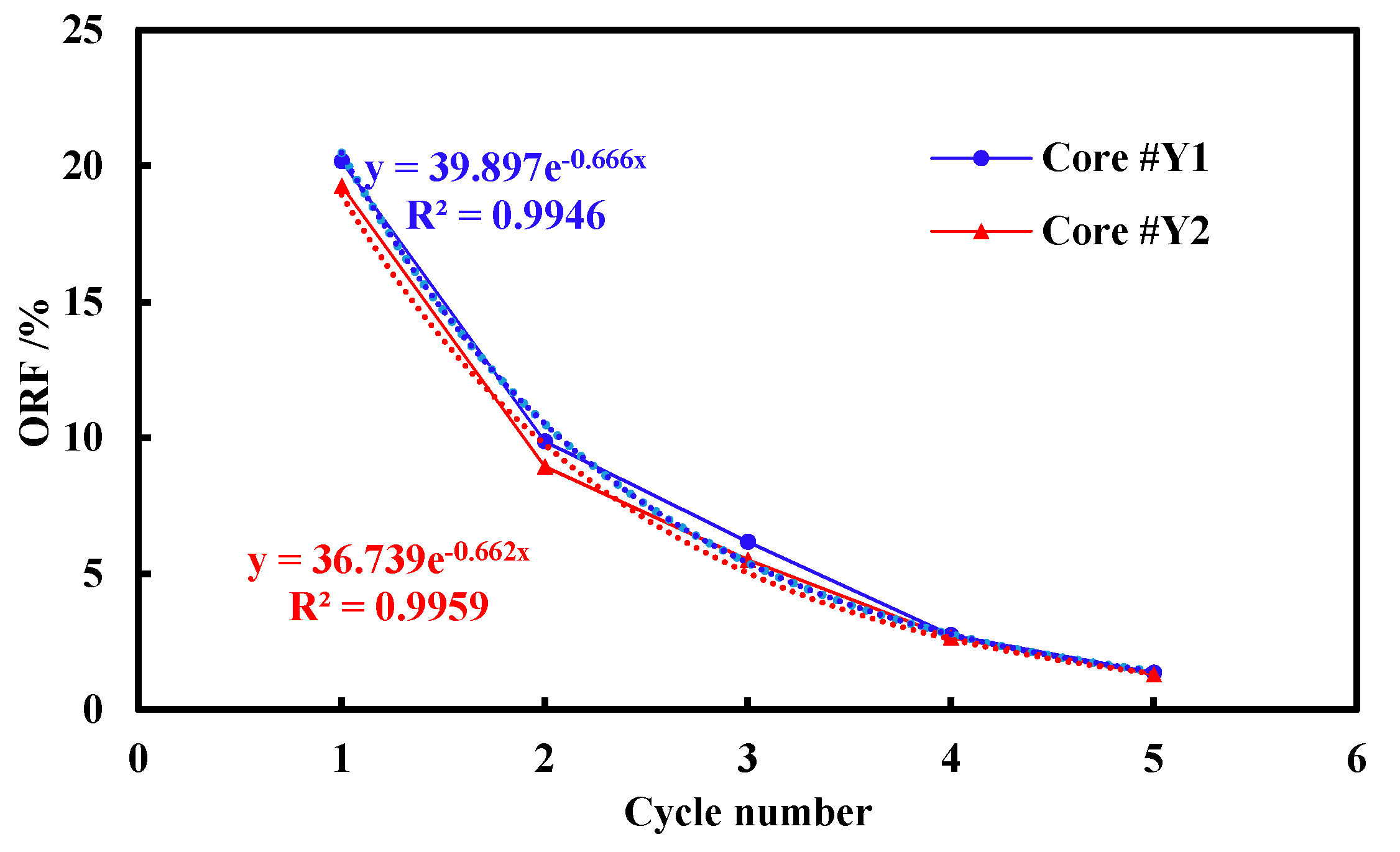
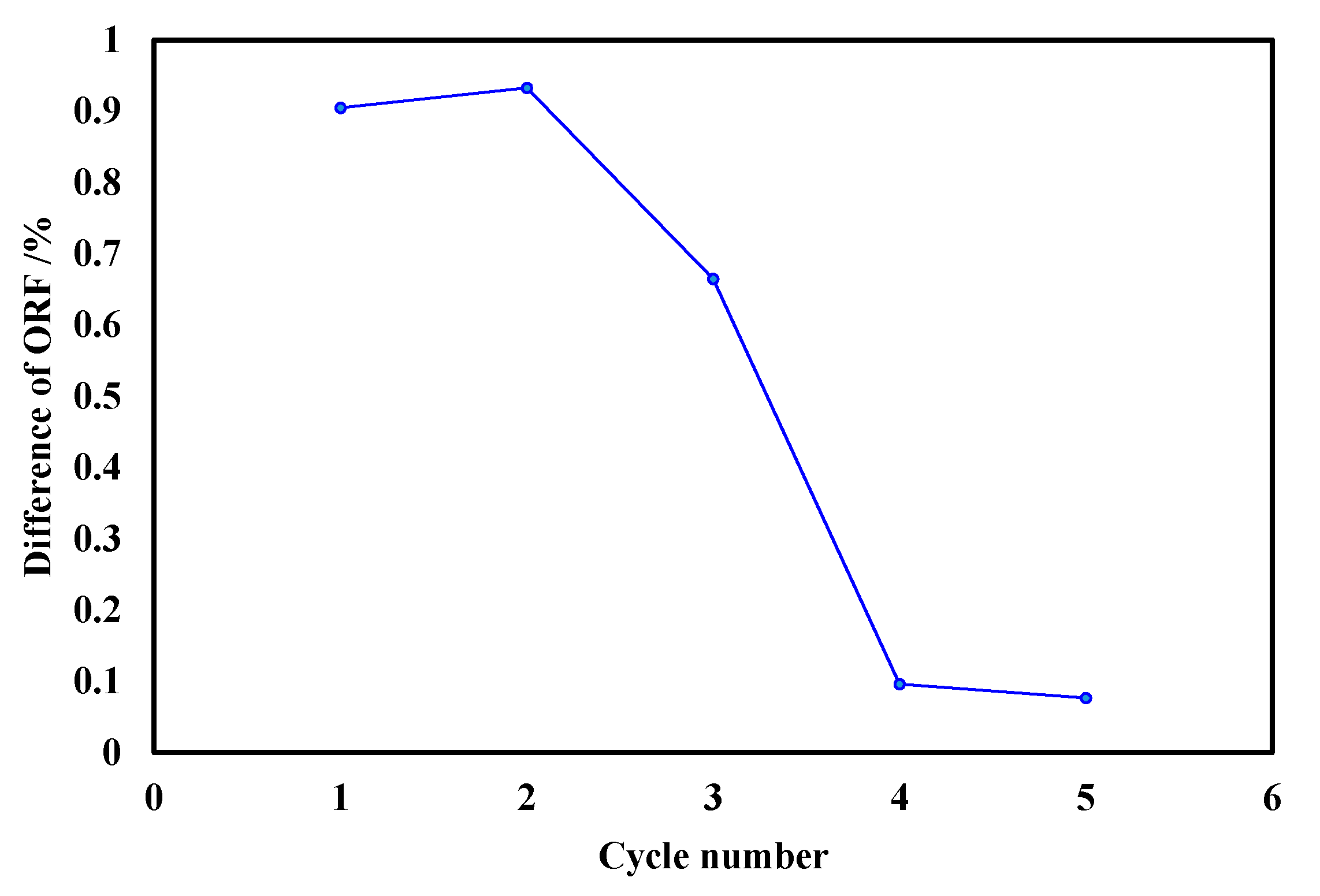
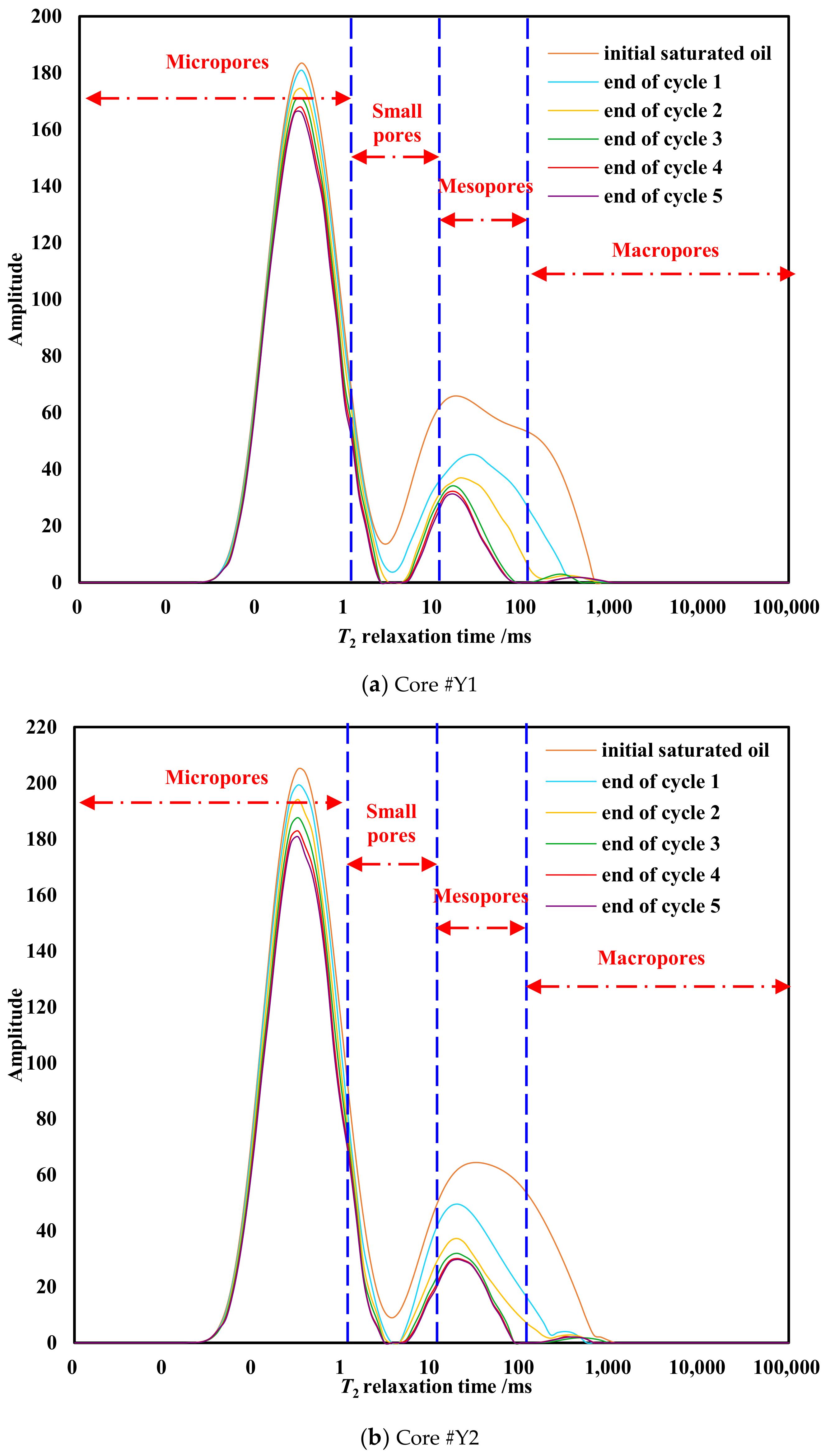

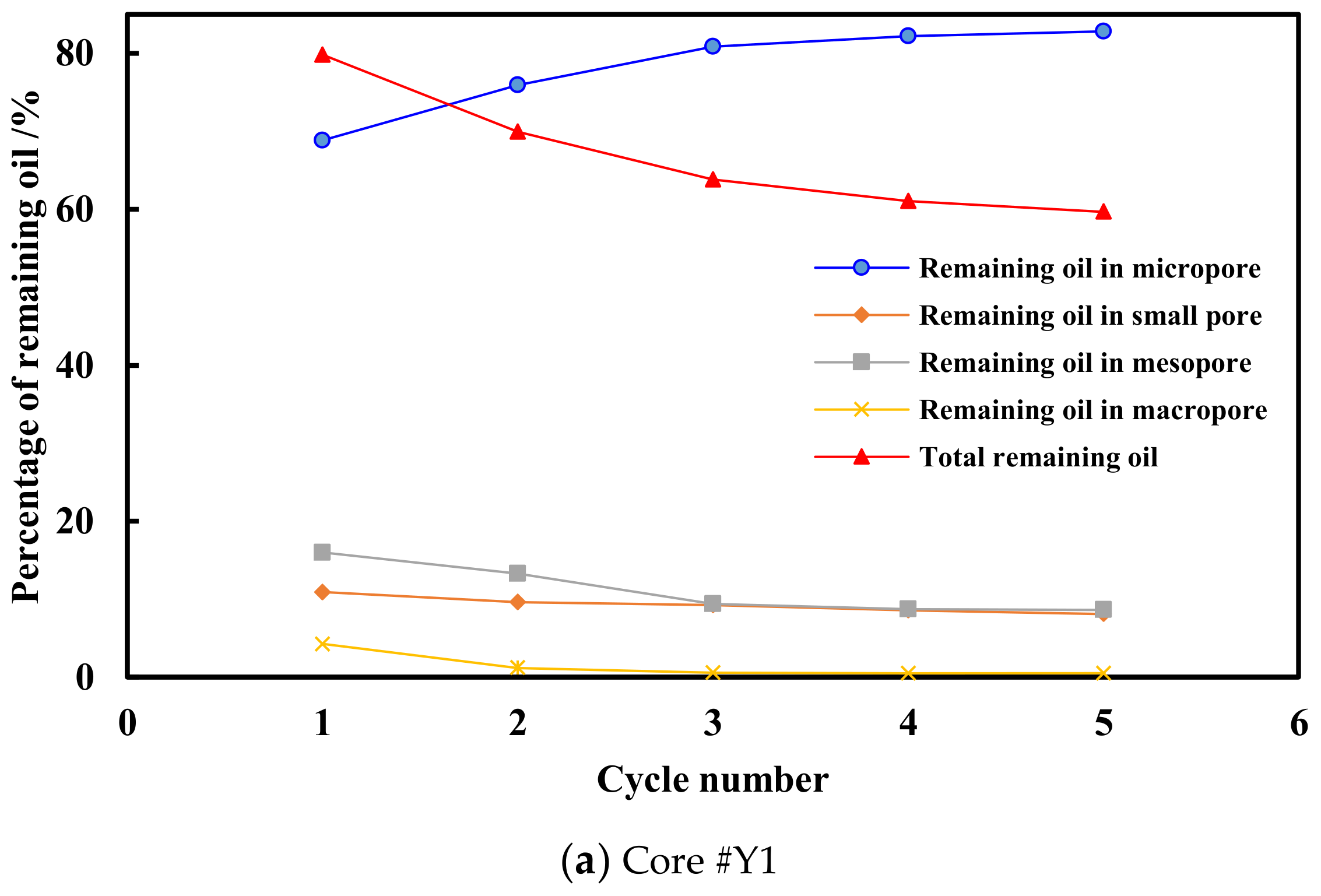
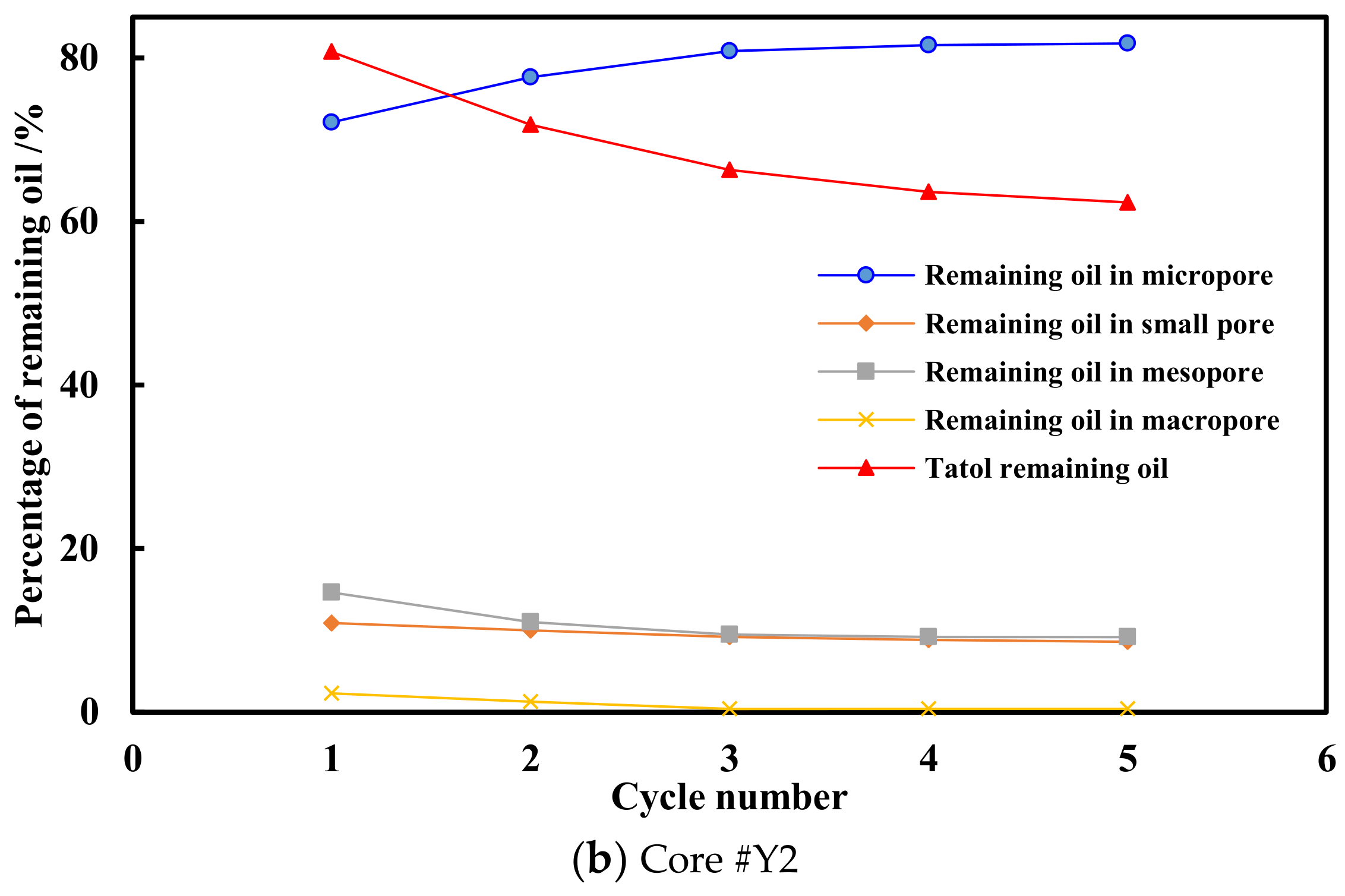
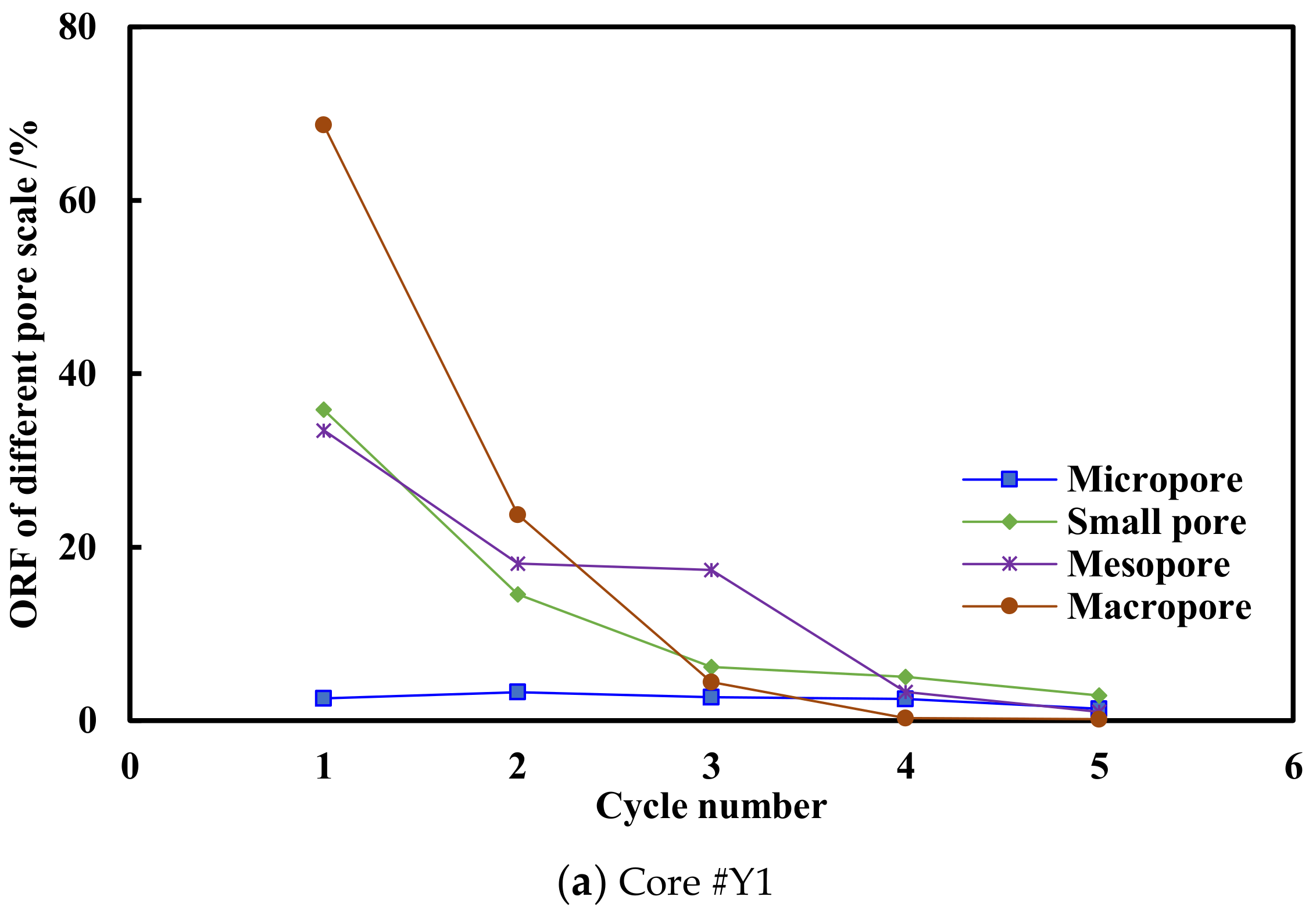
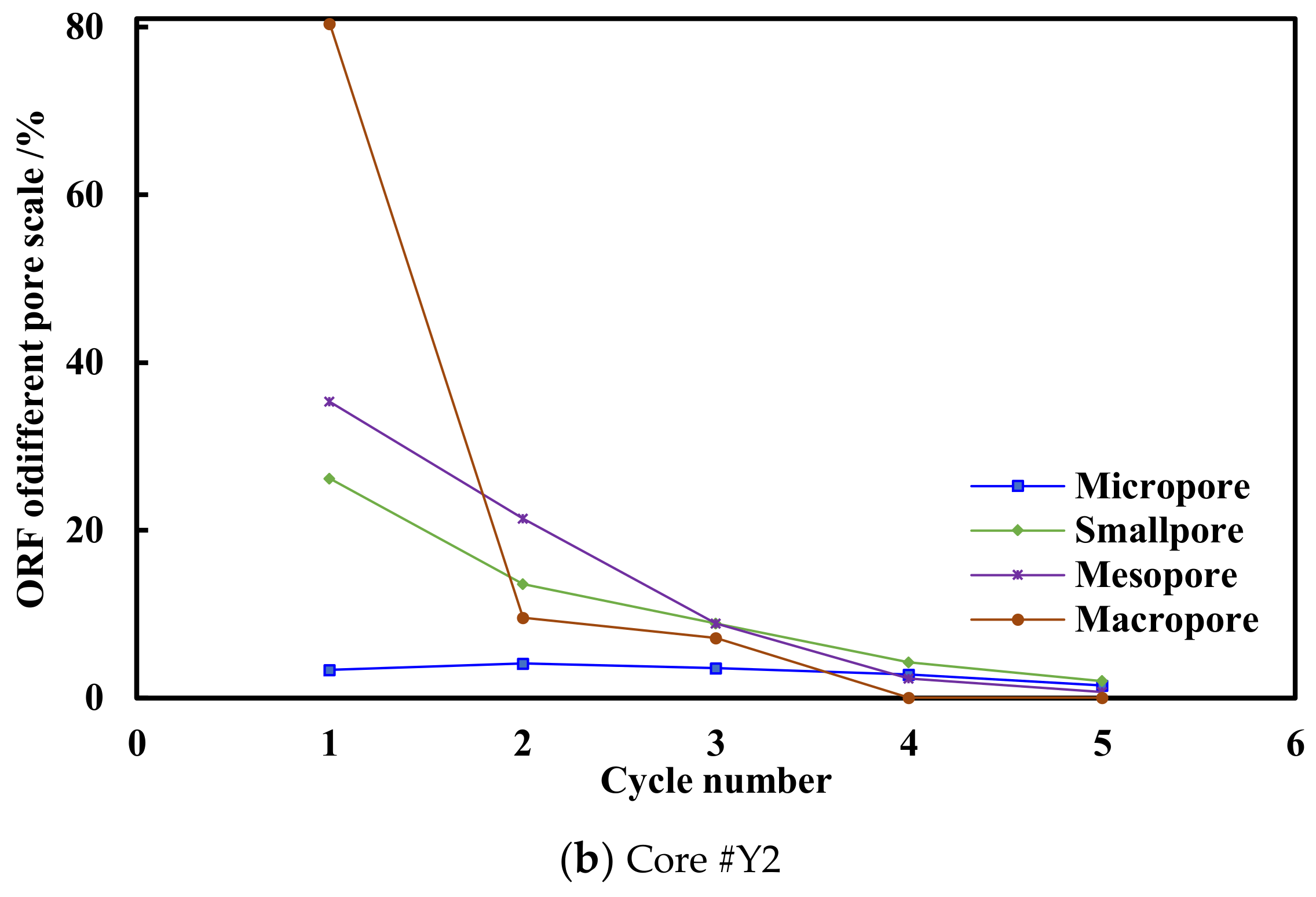
| Core No. | Diameter, cm | Length, cm | Porosity, % | Permeability, 10−3 μm2 |
|---|---|---|---|---|
| Core #Y1 | 2.498 | 3.423 | 5.77 | 0.2911 |
| Core #Y2 | 2.500 | 3.573 | 6.06 | 0.0169 |
| T2 Relaxation Time, ms | Pore Radius, μm | Pore Type |
|---|---|---|
| T2 < 1 | r < 0.020 | micropore |
| 1 ≤ T2 < 10 | 0.020 ≤ r < 0.25 | smallpore |
| 10 ≤ T2 < 100 | 0.25 ≤ r < 2.0 | mesopore |
| T2 ≥ 100 | r ≥ 2.0 | macropore |
| Core No. | Micropore <r1 | Smallpore r1 ≤ r < r2 | Mesopore r2 ≤ r < r3 | Macropore ≥r3 |
|---|---|---|---|---|
| Core #Y1 | 56.38 | 13.57 | 19.19 | 10.85 |
| Core #Y2 | 60.26 | 11.93 | 18.29 | 9.53 |
| Cycle Number | Core #Y1 | Core #Y2 | ||||||
|---|---|---|---|---|---|---|---|---|
| Micro <r1 | Small r1 < r < r2 | Meso r2 < r < r3 | Macro >r3 | Micro <r1 | Small r1 < r < r2 | Meso r2 < r < r3 | Macro >r3 | |
| 1 | 7.10 | 24.11 | 31.85 | 36.95 | 10.51 | 16.21 | 33.53 | 39.75 |
| 2 | 18.65 | 20.03 | 35.19 | 26.13 | 27.88 | 18.16 | 43.76 | 10.20 |
| 3 | 24.85 | 13.54 | 53.87 | 7.74 | 38.96 | 19.19 | 29.48 | 12.38 |
| 4 | 50.96 | 24.91 | 23.06 | 1.07 | 64.57 | 19.34 | 15.89 | 0.21 |
| 5 | 55.94 | 28.71 | 14.07 | 1.27 | 70.51 | 18.72 | 10.36 | 0.42 |
| CO2 Mechanism | Approach Tool |
|---|---|
| 1: CO2 diffusion and molecular diffusion | Lab and simulation |
| 2: Reduction in Capillary forces | Lab and simulation |
| 3: Dissolution | Lab |
| 4: Replacement | Lab |
| 5: Miscible | Simulation |
| 6: Repressurization | Lab |
| 7: Extraction | Lab |
| 8: Oil swelling and pressure maintenance | Lab and simulation |
| 9: Oil Viscosity reduction | Lab and simulation |
| 10: Combination of more than one mechanism from above | – |
Publisher’s Note: MDPI stays neutral with regard to jurisdictional claims in published maps and institutional affiliations. |
© 2021 by the authors. Licensee MDPI, Basel, Switzerland. This article is an open access article distributed under the terms and conditions of the Creative Commons Attribution (CC BY) license (https://creativecommons.org/licenses/by/4.0/).
Share and Cite
Zhu, J.; Chen, J.; Wang, X.; Fan, L.; Nie, X. Experimental Investigation on the Characteristic Mobilization and Remaining Oil Distribution under CO2 Huff-n-Puff of Chang 7 Continental Shale Oil. Energies 2021, 14, 2782. https://doi.org/10.3390/en14102782
Zhu J, Chen J, Wang X, Fan L, Nie X. Experimental Investigation on the Characteristic Mobilization and Remaining Oil Distribution under CO2 Huff-n-Puff of Chang 7 Continental Shale Oil. Energies. 2021; 14(10):2782. https://doi.org/10.3390/en14102782
Chicago/Turabian StyleZhu, Jianhong, Junbin Chen, Xiaoming Wang, Lingyi Fan, and Xiangrong Nie. 2021. "Experimental Investigation on the Characteristic Mobilization and Remaining Oil Distribution under CO2 Huff-n-Puff of Chang 7 Continental Shale Oil" Energies 14, no. 10: 2782. https://doi.org/10.3390/en14102782





